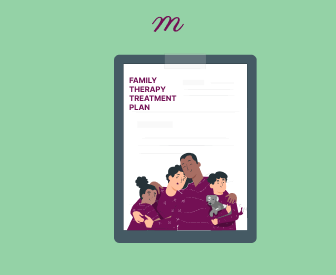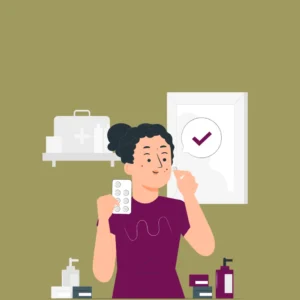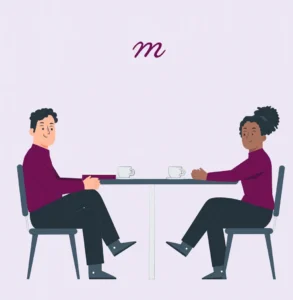As a therapist wishing to write an effective family therapy treatment plan, you must first understand the family dynamics, identifying relevant issues while developing structured, collaborative goals to address the problems initially identified by the family members.
Follow these steps to create a tailored, clear, and comprehensive family therapy treatment plan:
- Conduct a thorough intake assessment to identify presenting problems, understand family dynamics, and pinpoint individual concerns.
- Collaboratively establish measurable and achievable goals with the family, outlining specific interventions and strategies to address those goals.
- Document progress and adjust the treatment plan as needed.
Elements of a family therapy treatment plan:
Client Information
- Family members
- Presenting problems
- Demographic information
- Insurance details
Assessment and Diagnosis
- Description of family dynamics and interactions
- Identification of contributing factors (e.g., communication patterns, conflict resolution styles)
- Relevant diagnoses
Treatment Goals
- Goals that align with the family's needs and priorities
- Short-term goals (achievable within a few sessions)
- Long-term goals (overall desired outcomes)
Treatment Objectives
- Specific, actionable steps to achieve each goal
- Targeted behavioral change
- Skills to develop (e.g., active listening, assertive communication)
Interventions and Strategies
- Therapeutic approaches based on family dynamics and presenting concerns
- Examples of interventions and strategies a therapist might include in the plan:
- Communication skills training: Role-playing, using "I" statements
- Conflict resolution techniques: Identifying underlying issues, compromise
- Family systems therapy: Examining family patterns and roles
- Cognitive behavioral therapy: Identifying negative thought patterns and behaviors
- Psychoeducation: Providing information about relevant mental health conditions
Treatment Modality
- Frequency and duration of sessions
- Individual sessions (if needed)
- Family sessions
Progress Monitoring and Evaluation
- Conduct regular assessments to track progress toward goals
- Use standardized measures or rating scales
- Request feedback from family members to adjust interventions as needed
Important Elements to Consider
When completing a family therapy treatment plan, therapists must consider the following issues:
Family engagement. Involve all family members in the treatment planning process for buy-in and ownership.
Cultural sensitivity. Consider cultural factors that may influence family dynamics and communication styles.
Ethical considerations. Maintain confidentiality and clearly define boundaries.
Flexibility. Adapt the treatment plan as needs and dynamics change over time.
Here's a step-by-step guide, with examples, on how to write a family therapy treatment plan:
Step 1. Identify the Presenting Issues. Assess the family's primary challenges through observation, discussion, and assessment tools. This could include relationship conflicts, communication problems, behavioral issues, etc.
Example Presenting Issue: The Johnson family reports frequent arguments and a lack of communication between the parents (Chris and Ana) and the three children (Sally, age 17; Bobby, age 15; Gwen, age 13). Parents express concerns about their teenage son's withdrawal from family activities and his decline in school performance.
Step 2. Define Treatment SMART Goals. Create Specific, Measurable, Achievable, Relevant, and Time-bound (SMART) family goals. Each family member may have goals, but the overall focus is improving family dynamics.
Example
- Specific: The Johnson family will improve communication by practicing active listening skills during family meetings.
- Measurable: All family members will participate in a family meeting once a week for 30 minutes.
- Achievable: Each family member will take turns speaking and practice active listening skills (e.g., no interruptions when other members are talking).
- Relevant: This goal will help reduce conflict and promote understanding.
- Time-bound: The family will practice these skills for six weeks, and progress will be reviewed in therapy.
Step 3. Identify Interventions. List the goal-specific interventions and therapeutic techniques to address the family's presenting problems.
Examples
- Role-playing to teach active listening and assertive communication.
- Weekly family meetings where members express their feelings and concerns in a non-judgmental environment.
- Agreements and contracts for family members regarding expectations (e.g., Bobby agrees to attend school consistently and engage in one family activity per week).
- Parent education tools to encourage positive behaviors in Bobby through praise and positive reinforcement.
Step 4. Assign Roles and Responsibilities. To increase accountability, define each member’s role and how they will contribute to achieving the family’s goals.
Example
- Chris and Ana will initiate family meetings and model active listening skills. They will not criticize each other or the children during these discussions.
- Bobby will participate in the family meetings by sharing his feelings without retreating, yelling, or avoiding the conversation.
Step 5. Monitor Progress and Make Adjustments. Regularly check in on the goals and interventions and how the family is progressing toward the identified goals.
Example
- After six sessions, the therapist will review the family’s progress by discussing how well the communication goals have been met. Adjustments will be made based on the family’s feedback and observed improvements or setbacks.
Family Therapy Treatment Plan
Family Name: The Johnson Family: Chris, Ana, Bobby, Sally, and Gwen
Date: September 25, 2024
Therapist: Dr. Jane Smith
Presenting Problem: The family struggles with communication, and the parents express concern about their son’s withdrawal and school difficulties.
Goal 1: Improve Family Communication
- Objective: The Johnson family will practice active listening during weekly family meetings.
- SMART Goal: The family will hold one 30-minute weekly family meeting for six weeks, during which each member will speak without interruptions or criticism.
- Intervention:
- Teach active listening and "I" statements during sessions.
- Role-play communication strategies.
- Assign weekly family meetings with specific topics to discuss.
- Responsible Family Members:
- Chris and Ana (parents): Initiate meetings and model positive communication.
- Bobby: Attend and actively participate in family meetings.
- Sally: Attend and actively participate in family meetings.
- Gwen: Attend and actively participate in family meetings.
- Review Date: After six sessions.
Goal 2: Increase Participation in Family and School Activities
- Objective: The children will participate in one weekly family activity. Bobby will attend school regularly.
- SMART Goal: Bobby will submit all school assignments on time for the next eight weeks.
- Intervention:
- Use a behavioral contract with positive reinforcement (e.g., extra video game time or privileges) for attending family activities and school regularly.
- Discuss school difficulties and provide emotional support during therapy sessions.
- Responsible Family Members:
- Bobby: Complete schoolwork and attend school each day.
- Sally, Bobby, and Gwen: Participate in one weekly family activity.
- Chris and Ana: Monitor progress and provide positive reinforcement.
- Review Date: After eight weeks.
Goal 3: Reduce Conflict Between Parents and Children
- Objective: Reduce verbal conflicts and misunderstandings between parents and teenage children.
- SMART Goal: For the next four weeks, all family members will use a “pause” technique during arguments, taking a 5-minute break when emotions rise.
- Intervention:
- Teach the "pause and reflect" therapy method.
- Practice de-escalation techniques during role-play.
- Assign the use of this method during any arguments at home.
- Responsible Family Members:
- Chris and Ana: Initiate the “pause” when conflicts arise.
- Sally, Bobby, and Gwen: Agree to take the 5-minute break and resume conversations calmly.
- Review Date: After four weeks.
Step 6. Next Steps. After setting goals, identifying appropriate interventions, and assigning roles, agree on follow-up sessions and monitor progress regularly. The therapist must consistently review the treatment plan and make necessary adjustments based on the family’s ongoing needs.
Reference
Patterson, J., et. al. (2018). Essential Skills in Family Therapy: From the First Interview to Termination, Third Edition. Guilford Press.
Why other mental health professionals love Mentalyc

“If I were recommending this software to a colleague, I would tell them that it is the best thing that they could do for their practice.”
Licensed Professional Counselor

“For those who have hesitations … It is a lifesaver. It will change your life and you have more time to be present with your patients.”
Licensed Clinical Social Worker

“Do yourself a favor, make your life easier. Use the tools that are readily available … I found Mentalyc to be one of the best tools that I’ve ever used.”
Licensed Marriage and Family Therapist

“It immediately changed my quality of life, personally and professionally. I went from 3–4 hours a week of notes to 1 hour at most … that alone is invaluable personally and professionally.”
Owner/Independently Licensed Marriage & Family Therapist (IMFT)







